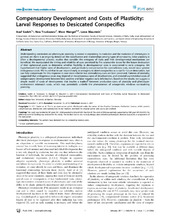Compensatory Development and Costs of Plasticity: Larval Responses to Desiccated Conspecifics
Peer reviewed, Journal article
Published version
Permanent lenke
http://hdl.handle.net/1956/5273Utgivelsesdato
2011-01-05Metadata
Vis full innførselSamlinger
Originalversjon
https://doi.org/10.1371/journal.pone.0015602Sammendrag
Understanding constraints on phenotypic plasticity is central to explaining its evolution and the evolution of phenotypes in general, yet there is an ongoing debate on the classification and relationships among types of constraints. Since plasticity is often a developmental process, studies that consider the ontogeny of traits and their developmental mechanisms are beneficial. We manipulated the timing and reliability of cues perceived by fire salamander larvae for the future desiccation of their ephemeral pools to determine whether flexibility in developmental rates is constrained to early ontogeny. We hypothesized that higher rates of development, and particularly compensation for contradictory cues, would incur greater endogenous costs. We found that larvae respond early in ontogeny to dried conspecifics as a cue for future desiccation, but can fully compensate for this response in case more reliable but contradictory cues are later perceived. Patterns of mortality suggested that endogenous costs may depend on instantaneous rates of development, and revealed asymmetrical costs of compensatory development between false positive and false negative early information. Based on the results, we suggest a simple model of costs of development that implies a tradeoff between production costs of plasticity and phenotypeenvironment mismatch costs, which may potentially underlie the phenomenon of ontogenetic windows constraining plasticity.
